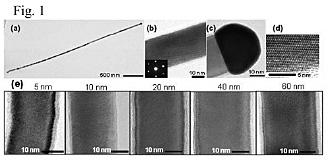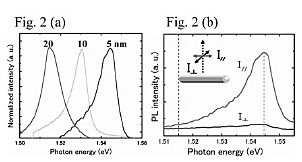Optical Science Laboratory
Semiconductor nanowires (NWs) have attracted considerable attention owing
to the interesting fundamental properties of such low-dimensional systems
and the exciting prospects of utilizing these materials in nanotechnology-enabled
electronic and photonic applications. NWs are expected to provide the building
blocks with which to form new nanostructures and realize novel 1-dimensional
structures. To explore the potentially unique applications of these freestanding
NW building blocks, we synthesized freestanding GaAs NWs with a controlled
diameter and studied their optical properties with the radial quantum-confinement
effect.
The NW growth was undertaken in a metalorganic vapor phase epitaxy system
and Au nanoparticles were used to catalyze the NW growth via the vapor-liquid-solid
(VLS) mode [1]. We controlled the diameter of the GaAs NWs by using size-selective
Au colloidal particles with nominal diameters of 5, 10, 20, 40, and 60
nm [2]. We characterized the structure and diameter of the NWs using transmission
electron microscopy (see Fig. 1). We successfully controlled the NWs with
very few stacking faults by growing them at a very low temperature. We
studied their optical properties by employing micro-photoluminescence (PL)
at 3.6 K [3]. Figure 2(a) shows PL spectra from individual NWs of different
Au particle sizes. PL peak energies clearly exhibit the blue shift with
decreasing Au particle size due to the radial quantum-confinement effect
[2]. We analyzed the absorption and emission polarization characteristics
of these NWs and found large anisotropies between polarization resolved
PL spectra (see Fig. 2(b)). These results suggest that both the dielectric
constant contrast and the quantum-confinement effect have to be considered
[2]. This work opens the way to investigating size-related optical phenomena
in bare GaAs quantum wires, and provides more opportunities for the study
of one-dimensional quantum physics using freestanding NWs.
[1] G. Zhang et al., J. Appl. Phys. 103 (2008) 014301.
[2] G. Zhang et al., Appl. Phys. Lett. 95 (2009) 123104.
[3] G. Zhang et al., Jpn. J. Appl. Phys. 49 (2010) 015001.
 |
 |
|||||
|
|